The flight simulator is an essential device in pilot training. They are a tool that perfectly complements training in real aircraft, as they allow students to train in a wide variety of scenarios and situations – often difficult to reproduce in real flight – which will allow them to gain experience and put into practice the theoretical knowledge learnt in class.
Simulators to be used for flight crew training must have a valid FSTD (Flight Simulation Training Device) qualification certificate issued by the competent authority. The organisations that regulate the validity of simulators differ depending on the region where the simulators are used. For example, the North American FAA (Federal Aviation Administration), the european EASA (European Aviation Safety Agency), which in Spain, as a member of the EASA, is managed by the AESA (Agencia Estatal De Seguridad Aérea).
In order to achieve the FSTD rating, simulators must meet a number of very specific conditions. Among them, they must faithfully emulate the behaviour, reactions and performance of the aircraft they simulate.
The certification process lasts for the entire manufacturing process of the simulator. At each stage, the necessary documents are generated in order to be accredited. User manuals, procedures manuals and software and equipment version control manuals are generated.
Documentation
In order to be certified as eligible airborne simulators, FSTD manufacturers must submit:
- FSTD Operating Manual
- IOS Operating Manual
- List of malfunctions reproduced by the FSTD
- FSTD Maintenance Manual
- FSTD Equipment List
- FSTD Subjective Test Acceptance Manual
- List of FSTD installation drawings
The end of the process is the creation of the QTG (Qualification Test Guides) where the technical characteristics of the simulator are specified, how it is tested and checked for correct operation.
Once the simulator has undergone objective testing, the regulatory organisation certifies that the simulator complies with the design and performance standards that resemble the aircraft it simulates.
Simulators are certified on a model-by-model basis once installed and operating at the operator’s location. In case of a change of location they must be recertified after relocation.
Certifications are renewed periodically.
Certifications
EASA determines different simulator ranges with respect to the fidelity of the simulated aircraft.
Firstly, there are the simplest simulators, the BITD (Basic Instrument Training Device).
BITDs do not simulate any specific aircraft or model and are primarily used to familiarise pilots with general piloting concepts.
To qualify for FNTP (Flight Navigation Procedures Trainer) status, simulator fidelity must also be advanced. To achieve this certification, simulators must comply with general aspects of a particular class of aircraft. In this certification there are three categories FNTP FNTP II and FNPT II + MCC (Multi-crew Coordination Training). Although they do not have to be exactly the same as the cockpit of a specific aircraft model, to be certified as FNTP II, for example, they are required to have a complete and enclosed cockpit, which complies with the type of engine and the MTOW (Maxium Take-Off Weight) of the aircraft class they reproduce.
FTD (Flight Training Device) simulators are devices that mimic a specific aircraft model. This means that they must emulate both the systems and procedures of the specific model. There are two types in this category, the FTD 1 and the FTD 2. Their main difference is the number of aircraft systems they accurately reproduce.
Finally, there are the FFS (Full Flight Simulator). These simulators emulate specific aircraft in terms of behaviour, movement, procedure and systems. In this category we find FFS A, FFS B, FFS C, FFS D, being FFS D the most reliable. Their cockpit is identical to that of the model they simulate and the behaviour is imitated by means of the real information that the aircraft manufacturer possesses. These are the simulators used to obtain aircraft Type Rating.
Simulators in EAS
At EAS Barcelona we have two FNTP II simulators that faithfully simulate the twin-engine aircraft model used by the school, the Tecnam P2006. This represents a notable advantage for the students compared to using a generic simulator, as the response is identical to that of the aircraft used in the real flight sessions. One unit is based at the school’s Barcelona headquarters and the other at EAS Barcelona’s flying facilities at Sabadell airport.
EAS Barcelona also has an FNTP II + MCC which, in this case, represents an Airbus A320. One of the most widely used commercial aircraft in the world by airlines.
This is used to instruct students in the teamwork that is carried out in a commercial aircraft (MCC) as well as the necessary transition from the internal combustion engines that equip the school aircraft in which the student has flown during their training to the turbine engines that equip the aircraft in which they will most likely carry out their professional activity in the future.
All the school’s simulators are certified by EASA, of course, but in the case of the Airbus A320 simulator the certification is “MCC enhanced”, which allows training to be given including the company standards (APS) and an extended MCC that includes forty hours of flight and 50 hours of theory, which doubles the duration of a “normal” MCC and is very useful when applying for a place in any airline.
